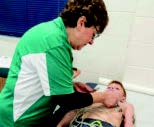No one’s a bigger cheerleader than a parent rooting for a young athlete. Along with the pride and pleasure of seeing a child play, however, comes concern:
What about those news reports of sudden cardiac arrest during games or practice?
What if he or she gets a concussion?
The Matthew J. Morahan III Health Assessment Center for Athletes (MJM), a Saint Barnabas Medical Center facility, exists to address those concerns. Based in Livingston, MJM also offers a mobile program that conducts cardiac and concussion screenings at schools and sports centers throughout the state. To date, the program has served more than 30,000 young athletes in more than 30 schools.
SCREENING THE HEART
Sudden cardiac arrest (SCA) in youth sports is rare—about 100 cases are reported nationwide each year—but it is the leading cause of death in young athletes. The major causes are undiagnosed heart problems.
MJM offers cardiac screenings for children ages 6 to 18, including a questionnaire of family history and symptoms. Though an electrocardiogram (EKG) is not required by the state for sports physicals, it is standard in the MJM screening. Among the conditions an EKG may pick up are Long QT syndrome and certain other heart rhythm disorders, as well as thickened, injured or diseased heart muscle caused by hypertrophic cardiomyopathy (HCM).
“I probably can rule out 90 percent of the causes of sudden cardiac arrest,” says Donald Putman, MD, Division Chief of Pediatric Cardiology and Medical Director of Cardiac Evaluation and Assessment for MJM. “I can’t say we can rule out 100 percent. But if we can identify even one child at risk through what we’re doing, that is worth it.”
If heart issues are discovered, doctors may prescribe further workup and a consultation with a pediatric cardiologist. If no issues are found, young athletes are encouraged to come back every two years for another screening that can be compared to the baseline tests.
“The goal is not to terrify people, but to try to protect young athletes and also not take them out of the things they love to do,” Dr. Putman says.
WHAT IS SUDDEN CARDIAC ARREST?
With sudden cardiac arrest (SCA), the heart stops beating, blood stops flowing to the brain and vital organs, and death can follow within minutes.
In young athletes, the two major causes are an abnormally thickened heart muscle known as hypertrophic cardiomyopathy (HCM), or a congenital abnormality in a coronary artery. While some children with these or other heart conditions show symptoms such as lightheadedness, chest pain or shortness of breath during exercise, many others display no symptoms at all before SCA.
In New Jersey, all public and private K through 12 schools are required to have an automatic external defibrillator (AED) and trained staff on site, thanks to Janet’s Law, named after an 11-year-old Warren Township girl who died from SCA while at cheerleading practice.
CONCUSSION CHECKS
A recent national survey found that 15 percent of students reported having had at least one concussion related to physical activity in the previous 12 months. New Jersey requires schools to develop policies and educate coaches, athletes and parents about concussions, but misconceptions remain.
“A lot of times, kids don’t think to say anything after they’ve taken a hit,” says Diana Toto, MS, Director of Sports Medicine and Business Development for Saint Barnabas Medical Center. “They have a headache but don’t think anything of it, or at times athletes have a delay in symptoms, which could present several days following an injury. This is why it is crucial to remove a child from play right away with any suspected concussive event.”
As with cardiac screenings, a baseline concussion screening provides valuable data. MJM assesses memory, reaction time and concentration. If the athlete later has a possible concussion, he or she can re-take the tests.
“You can’t see a concussion or do a blood test for it,” says John Shumko, MD, PhD, Medical Director of Sports Injury and Assessment at MJM and a member of Barnabas Health Medical Group. “But the eyes are a window to the brain, and are connected to so many neurological centers that you can test their movements to confirm the existence of a concussion.”
If a concussion is confirmed, MJM has a well-developed set of guidelines that determine when an individual can go back to school, back to practice and, finally, back to playing his or her sport.
“We are a comprehensive center, a one-stop shop,” Dr. Shumko says. “We recently had a father bring his son in for a screening after he’d taken a hit to the head on the field. A local hospital had given the boy a scan and told him he was fine.
“But when he came here, it was a totally different evaluation. We not only treated him for the concussion, we found a heart murmur that had never been identified, and we routed him immediately to have a cardiac screening and see Dr. Putman.
“That’s the kind of thing that’s going on here every day, and I can’t express how great it is, and how rewarding it is for us.”
WHAT IS A CONCUSSION?
A concussion is a traumatic brain injury caused by a blow or jolt to the head or body that causes the brain to bounce or twist in the skull. It can result in chemical changes in the brain and damage to brain cells, and can affect brain development. Students with inadequately treated concussions perform significantly worse on measures of attention and concentration. Repeat concussions increase the risk of severe impairment.
To learn more about MJM, visit our website or call 973.322.7913.